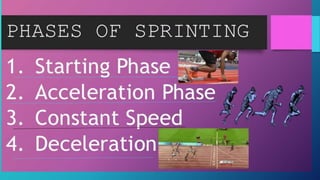Phases of sprinting
- 3. The initial phase of sprinting is known as the starting block phase, where the sprinter is in contact with the blocks This phase has the greatest amount of ground contact time, or the total time in which the feet are in contact with the ground or blocks. This is when force production is the greatest.
- 4. Acceleration is the transition from 0 to top-end speed. During the acceleration phase, the body gradually straightens and the strides lengthen.
- 5. The constant speed phase can be submaximal, maximal or supramaximal and is characterized by both the stride length and stride frequency remaining the same over a period of time. This phase is generally achieved between the 60 to 80 meter mark in men and 50 to 70 meter mark in women.
- 6. Deceleration Phase The last phase is categorized by a decrease in sprinting speed, usually occurring between the 80 and 100-meter mark in top sprinters






